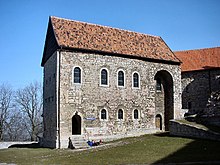



The double chapel, sometimes double church, is a chapelorchurch building with two storeys that either have a central aperture enabling their simultaneous use for services or are completely separate, just connected by a staircase, and used for different liturgical functions. In the latter type, there is often a crypt on the lower level and a celebratory space on the upper floor.
This special form of church building that was used in medieval European architecture up to the 13th century had two churches built on two levels, one above the other, usually with the same floor plan, but there are exceptions such as the Imperial Chapel of St. Ulrich in Goslar. The earlier arrangement of the two chapel floors, which was purported to enable a "separation between the lower and upper classes of the Middle Ages", in which the lower chapel was assigned to the "common people" and the upper chapel to the "feudal lords" and their families is not substantiated by any evidence. Instead, it is more likely that the distinction was either between a public lower chapel, where the ruler celebrated mass with guests before official events or during state visits, and a private upper chapel, where the lord's family worshipped; or between an upper chapel which was reserved for estate services and a lower chapel used as a crypt and also for requiem masses. In these Romanesque chapels the upper and lower levels were usually connected by a secondary aperture in the floor of the upper chapel. The double chapel had numerous architectural successors, notably the charnel house, a combination of cemetery chapel and ossuary, but also in numerous two-storey cemetery chapels in southern Germany, Austria and Bohemia. Where they function purely as cemetery chapels, double chapels are usually dedicated to Saint Michael. The lower chapel was given the character of an ossuary, as a Late Gothic relic chapel and memorial for the fallen after the failure of the feudal crusades (e.g. Kiedrich or Görlitz).
Germany:
Double chapels were mainly built in Hohenstaufen imperial palaces and castles, but also in monasteries. The best known are:
Rest of Europe
Armenia
| Authority control databases: National |
|
|---|